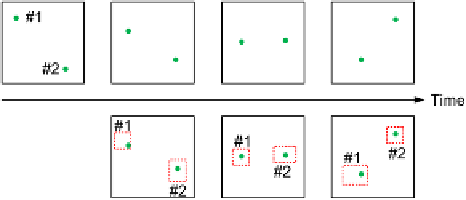Image Processing Reference
In-Depth Information
Fig. 9.4
The number of
object pixels as a function of
time. Note how the number
suddenly drops
Predicting is a delicate matter as we are talking about foreseeing the future. Care
should therefore be taken before using any of the methods and equations presented
above. But prediction in its simple form with a zeroth order or first order motion
model, and a large ROI, is nearly always a good idea. So is the notion of including
predicted values in the update when no detection is available.
9.3
Tracking Multiple Objects
Sometimes we need to track multiple objects at the same time. If the objects are
different we can duplicate the methods mentioned above and track each object indi-
vidually. When the objects are similar, however, we need a coherent framework that
can simultaneous track multiple objects.
In the top row of Fig.
9.5
we see two similar objects that we want to track. Re-
member that tracking is about finding the trajectory of the object over time, meaning
that we need to figure out which object is which in each image. This is known as a
data association
problem in the sense that we need to assign some data (here two
detected objects) to their respective trajectories. In the figure it is obvious that we
have an object to the left moving downwards while the object to the right moves up-
wards, but how does the computer infer this? The solution is to predict the ROI for
each object, as discussed above, and investigate which of the two objects best
match
the respective ROIs. This is illustrated in the bottom row in Fig.
9.5
. By includ-
ing the matching block into the tracking framework, we have now arrived at its final
structure, see Fig.
9.6
. This tracking framework is denoted the
predict-match-update
framework.
Unfortunately, tracking of multiple objects is not always as simple as illustrated
in Fig.
9.5
. When objects move they are likely to occlude each other, which will
result in objects disappearing or new objects appearing. Moreover, sometimes the
Fig. 9.5
Top row shows four
consecutive images
containing two moving
objects. In the bottom row the
dashed red boxes
indicate the
predicted ROIs. The numbers
(#1
and
#2) indicate which
trajectory an object is found
to belong to



